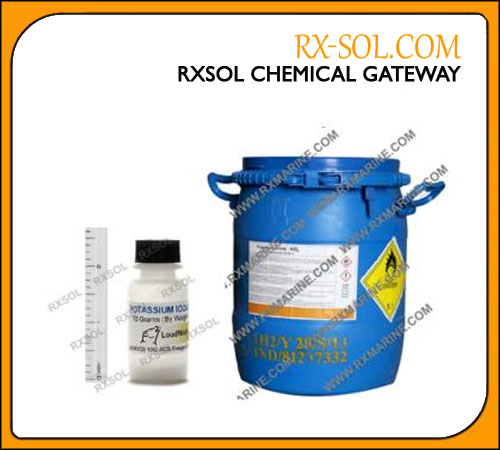Buffer Cleaner
Oman Chemical is leading one Largest Supplier, Manufacture a

Potassium Iodate manufacturer, supplier and exporter. Potassium Iodate is an oxidizing agent. Potassium Iodate used primarily as a stable source of Iodine, which is liberated in the presence of Iodide ion and acid, in the titration of Thiosulfate and Sulfite solutions.
Potassium Iodate (KIO3) may be used as an oxidizing agent in the estimation of hydrolyzable tannins (gallotannins and ellagitannins) in plant samples. It may also be used in the preparation of polyaniline,poly(o-anisidine),poly[aniline-co-(o-anisidine) and TiO2 nanoparticles.
Potassium Iodate also used for Iodization of edible salt
Potassium Iodate occurs as a white, crystalline powder. KIO3 can be used as a substitute of KI in radiation protection. A kinetic study of thermal degradation of KIO3 by γ-rays suggests that rate of decomposition increases while activation energy decreases upon irradiation.
Formula : KIO3 Molecular Wt. : 213.9927 ( or 214 )
Packing :
25 / 50 Kg net fibre drums to be polycoated. Palletized and Stretch – Wrapped
Labeling & Marking
Each pack shall additionally include on the label:
Stability :
Stable at ambient temperature in sealed containers.
Shelf life 5 years from manufacturing date.
Minimum 24 months remaining shelf life after arrival.
Storage & Handling :
Store in closed containers away from heat and moisture. Oxidizer. Keep away from combustible materials & strong acids. Wear goggles and rubber gloves when handling bulk quantities. Harmful if swallowed. Avoid contact with eyes, skin, and clothing. In case of spillage, collect into container for disposal. Flush with plenty of water.
QC Testing
Each batch ordered must be minimum FCC compliant and come with corresponding certificates of analysis Chemical analysis: all active ingredients are analysed via certification agent and must fall within the specified limits.
Identification :
Add 1 drop of starch TS and a few drops of 20% hypophosphorous acid to 1 mL of a 1:10 aqueous solution. A transient blue color appears.
Shipping information :
| Hazard Class | : 5.1 Oxidizing Substance |
| Label | : Oxidizer |
| Subsidiary Risk | : None |
| Marine Pollutant | : No |
| Proper Shipping Name |
: Oxidizing Solid N.O.S. (Potassium Iodate) |
Specification :
| Form | : Free-flowing crystalline powder |
| Colour | : White |
| Odour | : Odourless |
| Assay as KIO3 (on dry basis | : 99.0 – 101.0% |
| Iodide as I | : 0.002% Max. |
| Sulfates as SO4 | : 0.02% Max. |
| Bromate, Bromide, Chlorate & Chloride | : 0.01% Max. |
| Matter Insoluble in water | : 0.1% Max. |
| pH of 5% aqueous solution | : 6-8 |
| Heavy Metal as Pb | : 4 ppm Max. |
| Arsenic as As | : 3 pmm Max. |
| Iron as Fe | : 10 ppm Max. |
| Loss on Drying | : 0.5% Max. |
As additional criteria, the particle size for KIO3 must be minimum 95% below 500 μm (USP 35)
Physical Properties :
| Characteristics | : Specification |
| Bulk Density (approx.) | : 2.1 gm/cc |
| Particle Density | : 3.9 gm/cc |
| Solubility (approx.) | : 9.3 gm in 100 ml water at 25o C |
Microbiological :
| Characteristics | : Specification |
| Standard Plate Count | : 10 cfu/g Max. |
| Coliform Count | : 10 cfu/g Max. |
| Detection of Salmonella |
: 9.3 Absent /25 g |
Potassium iodate is an oxidizing agent and as such it can cause fires if in contact with combustible materials or reducing agents.
Potassium Iodate is widely used for salt iodisation in many developed and under developed countries as source of iodine.
Tablet of Potassium Iodate is widely used at the time of Nuclear Radiation
Potassium Iodate is widely used as a Laboratory Reagent.
Potassium Iodate is also used in Cattle Feed as a source of Iodine.
There are two forms of iodine that can be used to iodize salt: iodide and iodate, usually as the potassium salt. Iodate is less soluble and more stable than iodide and is therefore preferred for tropical moist conditions. Both are generally referred to as iodized salt.
Potassium Iodide also most commonly used in TABLE SALT to get iodide level in the salt...
Simply add 20 to 50 mg of Potassium Iodide / Potassium Iodate to 1 Kg Sale to get 20 to 50 ppm iodide label in the salt.
Pl. note Potassium iodide (KI) having 77% iodine percentage while potassium iodate (KIO3) have only 59% iodine. So pl. use what ppm level you required in your TABLE SALT.
Potassium Iodate exporter and supplier in Mumbai, Kandla, Kolkata, Chennai, Visakhapatnam, Fujairah, Dubai, Sharjah, Abu Dhabi, Ajman, Ruwi Ghala Barka Muscat - OMAN.